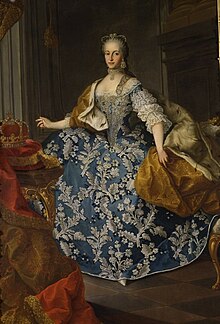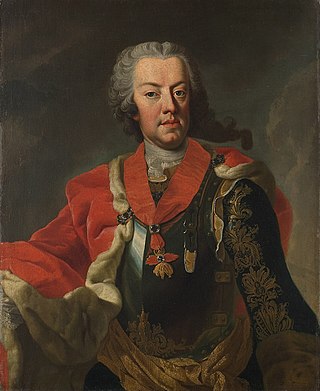| |||||
| Decades: | |||||
|---|---|---|---|---|---|
| See also: | Other events of 1766 List of years in Austria | ||||

Events from the year 1766 in Austria
| |||||
| Decades: | |||||
|---|---|---|---|---|---|
| See also: | Other events of 1766 List of years in Austria | ||||

Events from the year 1766 in Austria
| | This section needs expansion. You can help by adding to it. (October 2015) |
| | This section needs expansion. You can help by adding to it. (October 2015) |
| | This section needs expansion. You can help by adding to it. (October 2015) |

The Battle of Dresden was a major engagement of the Napoleonic Wars. The battle took place around the city of Dresden in modern-day Germany. With the recent addition of Austria, the Sixth Coalition felt emboldened in their quest to expel the French from Central Europe. Despite being heavily outnumbered, French forces under Napoleon scored a victory against the Army of Bohemia led by Generalissimo Karl von Schwarzenberg. However, Napoleon's victory did not lead to the collapse of the coalition, and the weather and the uncommitted Russian reserves who formed an effective rear-guard precluded a major pursuit. Three days after the battle, the Allies surrounded and destroyed a French corps advancing into their line of withdrawal at the Battle of Kulm.

Prince Charles Alexander Emanuel of Lorraine was a Lorraine-born Austrian general and soldier, field marshal of the Imperial Army, and governor of the Austrian Netherlands.

Johann Josef Wenzel Anton Franz Karl, Graf Radetzky von Radetz was a Czech nobleman and Austrian field marshal. He served as chief of the general staff in the Habsburg monarchy during the later period of the Napoleonic Wars and proved instrumental in the allied victory as one of the primary architects of the Trachenberg Plan and the Leipzig Campaign. Afterwards, he embarked on military reforms of the Austrian army. His reputation was one of discipline and fairness; he was revered by his troops among whom he was known as Vater ('Father') Radetzky. He is best known for the victories at the Battles of Custoza and Novara during the First Italian War of Independence. Johann Strauss I's Radetzky March was commissioned to commemorate Radetzky's victories at the Battle of Custoza.
Generalfeldmarschall was a rank in the armies of several German states and the Holy Roman Empire, (Reichsgeneralfeldmarschall); in the Habsburg monarchy, the Austrian Empire and Austria-Hungary, the rank Feldmarschall was used. The rank was the equivalent to Großadmiral in the Kaiserliche Marine and Kriegsmarine, a five-star rank, comparable to OF-10 in today's NATO naval forces.

The emperor of Austria was the ruler of the Austrian Empire and later the Austro-Hungarian Empire. The hereditary imperial title and office was proclaimed in 1804 by Francis II, Holy Roman Emperor, a member of the House of Habsburg-Lorraine, and continually held by him and his heirs until Charles I relinquished power in 1918.
Daun, Germany is a town in the Vulkaneifel district in Rhineland-Palatinate.

Count Leopold Joseph von Daun, later Prince of Thiano, was an Austrian field marshal of the Imperial Army in the War of the Austrian Succession and Seven Years' War. Daun is considered one of the outstanding military leaders from his time.

Franz Moritz Graf von Lacy was an Austrian military leader of Baltic German and Irish origins. He was the son of Count Peter von Lacy, and was a famous Austrian field marshal. Lacy served during the reign of Maria Theresa, and was a close friend to Joseph II, Holy Roman Emperor, becoming one of the latter's advisers. He was made a count of the Holy Roman Empire, while his father had been a count of the Russian Empire.

The Military Order of Maria Theresa was the highest military honour of the Habsburg monarchy, Austrian Empire and Austro-Hungarian Empire.

The Order of Saint Stephen is an order of chivalry founded in 1764 by Maria Theresa. In 1938, Miklós Horthy took the rights and activities of Grand Master as Regent of Hungary. The name of the Order changed to the Royal Hungarian Order of Saint Stephen. The Order was terminated at the time of the proclamation of the Second Hungarian Republic in 1946. It was recreated in 2011 as the Hungarian Order of Saint Stephen, and to this day remains the highest order in Hungary.

The Imperial and Royal Minister of War, until 1911: Reich Minister of War, was the head of one of the three common ministries shared by the two states which made up the dual monarchy of Austria-Hungary from its creation in the Compromise of 1867 until its dissolution in 1918.

Charles Marie Raymond d'Arenberg was the fifth Duke of Arenberg, 11th Duke of Aarschot and an Austrian field marshal.

Prince Charles Eugène of Lorraine-Brionne, Duke of Elbeuf was the head of and last male member of the House of Guise, the cadet branch of the House of Lorraine which dominated France during the Wars of Religion, remained prominent as princes étrangers at court throughout the ancien régime, and participated in the émigré efforts to restore the Bourbons to the throne. He was an officer in the French and Habsburg militaries during the French Revolutionary and Napoleonic wars.
Friedrich Moritz, Graf von Nostitz-Rieneck, was a field marshal in imperial service to the House of Habsburg. His nephew, Johann Nepomuk von Nostitz-Rieneck, was a general officer in Habsburg service during the Napoleonic Wars. He was a member of the noble Nostitz family.
Franz, Freiherr von Petrasch was an Austrian general officer serving in the Austrian Empire during the French Revolutionary Wars. He was the third generation of a bourgeois family in which two brothers, seeking adventure, joined the Habsburg military and rose through the ranks. The family was elevated to the Moravia nobility in the early eighteenth century, and to the Hungarian nobility in 1722.

Franz Anton von Zauner was an Austrian sculptor who worked in the Neoclassical style.

Events from the year 1760 in Austria

Philipp Franz Emerich Karl von Stadion und Thannhausen was an Austrian feldmarschall-leutnant and Landkomtur of the Teutonic Order in Austria.

The Maria Theresa Memorial is one of the most important monuments of the Habsburg monarchy in Vienna. It commemorates Empress Maria Theresa, who ruled the Habsburg monarchy from 1740 to 1780. The monument stands since 1888 on the Maria-Theresien-Platz between the Art History Museum, which opened in 1891, and the Natural History Museum, which opened in 1889.
![]() Media related to 1766 in Austria at Wikimedia Commons
Media related to 1766 in Austria at Wikimedia Commons